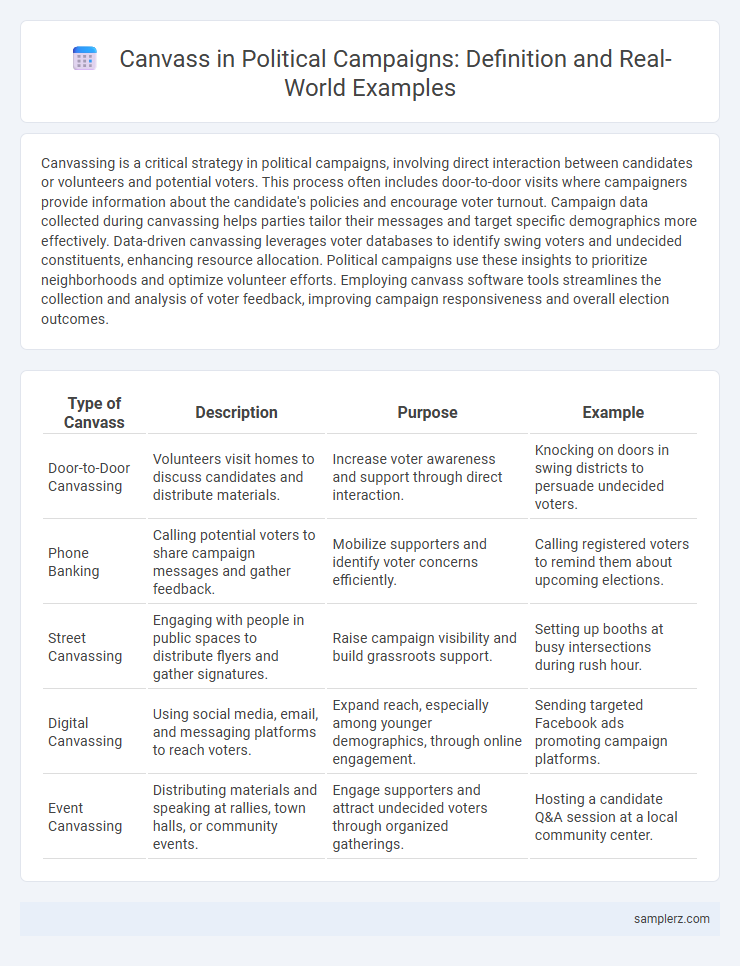Canvassing is a critical strategy in political campaigns, involving direct interaction between candidates or volunteers and potential voters. This process often includes door-to-door visits where campaigners provide information about the candidate's policies and encourage voter turnout. Campaign data collected during canvassing helps parties tailor their messages and target specific demographics more effectively. Data-driven canvassing leverages voter databases to identify swing voters and undecided constituents, enhancing resource allocation. Political campaigns use these insights to prioritize neighborhoods and optimize volunteer efforts. Employing canvass software tools streamlines the collection and analysis of voter feedback, improving campaign responsiveness and overall election outcomes.
Table of Comparison
| Type of Canvass | Description | Purpose | Example |
|---|---|---|---|
| Door-to-Door Canvassing | Volunteers visit homes to discuss candidates and distribute materials. | Increase voter awareness and support through direct interaction. | Knocking on doors in swing districts to persuade undecided voters. |
| Phone Banking | Calling potential voters to share campaign messages and gather feedback. | Mobilize supporters and identify voter concerns efficiently. | Calling registered voters to remind them about upcoming elections. |
| Street Canvassing | Engaging with people in public spaces to distribute flyers and gather signatures. | Raise campaign visibility and build grassroots support. | Setting up booths at busy intersections during rush hour. |
| Digital Canvassing | Using social media, email, and messaging platforms to reach voters. | Expand reach, especially among younger demographics, through online engagement. | Sending targeted Facebook ads promoting campaign platforms. |
| Event Canvassing | Distributing materials and speaking at rallies, town halls, or community events. | Engage supporters and attract undecided voters through organized gatherings. | Hosting a candidate Q&A session at a local community center. |
Understanding Canvassing in Political Campaigns
Canvassing in political campaigns involves direct voter interaction through door-to-door visits or phone calls to gather support and relay key messages. Effective canvassing leverages targeted voter data to customize communication strategies, increasing voter turnout and engagement. Political campaigns that use canvassing as a core tactic often see a significant boost in grassroots mobilization and voter persuasion.
Types of Canvassing Methods Used in Elections
Door-to-door canvassing remains a highly effective method in elections, allowing direct voter engagement through personal conversations and tailored messaging. Telephone canvassing leverages volunteers or automated systems to reach a broad audience quickly, facilitating immediate responses and voter data collection. Digital canvassing utilizes social media platforms and targeted online ads to influence younger demographics and expand campaign outreach efficiently across diverse voter segments.
Door-to-Door Canvassing: Approaches and Impact
Door-to-door canvassing remains a powerful campaign strategy, enabling direct voter engagement through personalized conversations and targeted messaging. Campaigns leverage data analytics to identify likely supporters, optimize canvasser routes, and track voter interactions, increasing outreach efficiency. Studies show that face-to-face canvassing can boost voter turnout by up to 10%, demonstrating its significant impact on election outcomes.
Phone Canvassing: Strategies and Best Practices
Phone canvassing in political campaigns involves targeted voter outreach through coordinated calling efforts to boost candidate support and turnout. Successful strategies leverage voter data segmentation, compelling scripts tailored to key demographics, and real-time feedback to refine messaging and enhance engagement. Integrating trained volunteers with robust call-tracking software maximizes efficiency and ensures comprehensive coverage of priority constituencies.
Volunteer Training for Effective Canvassing
Volunteer training for effective canvassing involves equipping campaign volunteers with essential communication techniques, voter data interpretation skills, and persuasive messaging strategies to engage potential supporters confidently. Comprehensive training programs emphasize role-playing scenarios, addressing common voter concerns, and using digital tools to track interactions and measure outreach success. These practices maximize volunteer impact, ensuring a consistent and compelling campaign presence that drives voter turnout and support.
Utilizing Technology in Modern Canvassing
Modern campaigning leverages technology through mobile apps and digital mapping tools to optimize canvassing routes and efficiently target voter demographics. Campaign teams use data analytics to identify swing voters and personalize outreach messages, increasing engagement and conversion rates. Real-time communication platforms enable instant coordination among volunteers, enhancing responsiveness and overall campaign effectiveness.
Target Voter Identification during Canvassing
Target voter identification during canvassing involves analyzing demographic data and voter history to prioritize outreach efforts toward likely supporters. Canvassers use voter files and predictive modeling to segment neighborhoods by political affiliation, age, and past voting behavior, maximizing resource efficiency. This targeted approach enhances voter turnout by tailoring messaging to individual preferences and concerns, increasing campaign impact.
Measuring the Success of a Canvassing Campaign
Tracking voter contact rate and response quality provides critical data for measuring the success of a canvassing campaign. Analyzing conversion metrics such as pledge sign-ups or voter turnout compared to baseline projections offers quantifiable insight into campaign effectiveness. Utilizing geographic information systems (GIS) to map engagement patterns enhances targeting strategies and optimizes resource allocation in future canvassing efforts.
Real-Life Examples of Successful Canvassing Efforts
Barack Obama's 2008 presidential campaign demonstrated the power of canvassing by organizing over 700,000 volunteers who knocked on millions of doors, significantly boosting voter turnout in key battleground states like Ohio and Florida. In the 2017 UK general election, the Labour Party's local canvassing efforts in urban areas like London and Manchester contributed to a 9.5% swing in vote share and unexpected seat gains. These campaigns leveraged data-driven targeting and personalized voter engagement to maximize impact and ensure efficient allocation of resources.
Overcoming Challenges in Political Canvassing
Political canvassing often encounters obstacles such as voter apathy, misinformation, and logistical challenges. Successful campaigns implement targeted outreach strategies, including data-driven voter segmentation to personalize messages and deploy volunteers effectively. Overcoming resistance during canvassing involves training canvassers in conflict resolution and utilizing real-time feedback to adapt approaches dynamically.

example of canvass in campaign Infographic
 samplerz.com
samplerz.com